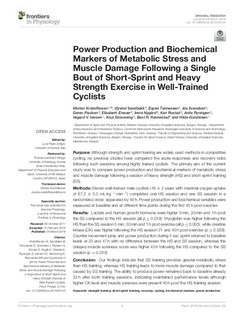| dc.contributor.author | Kristoffersen, Morten | |
| dc.contributor.author | Sandbakk, Øyvind | |
| dc.contributor.author | Tønnessen, Espen | |
| dc.contributor.author | Svendsen, Ida S. | |
| dc.contributor.author | Paulsen, Gøran | |
| dc.contributor.author | Ersvær, Elisabeth | |
| dc.contributor.author | Nygård, Irene | |
| dc.contributor.author | Rostad, Kari | |
| dc.contributor.author | Ryningen, Anita | |
| dc.contributor.author | Iversen, Vegard Vereide | |
| dc.contributor.author | Skovereng, Knut | |
| dc.contributor.author | Rønnestad, Bent | |
| dc.contributor.author | Gundersen, Hilde | |
| dc.date.accessioned | 2018-08-15T12:16:52Z | |
| dc.date.available | 2018-08-15T12:16:52Z | |
| dc.date.created | 2018-02-20T10:00:40Z | |
| dc.date.issued | 2018 | |
| dc.identifier.citation | Frontiers in Physiology. 2018, 9:155 1-9. | nb_NO |
| dc.identifier.issn | 1664-042X | |
| dc.identifier.uri | http://hdl.handle.net/11250/2558155 | |
| dc.description.abstract | Purpose: Although strength and sprint training are widely used methods in competitive cycling, no previous studies have compared the acute responses and recovery rates following such sessions among highly trained cyclists. The primary aim of the current study was to compare power production and biochemical markers of metabolic stress and muscle damage following a session of heavy strength (HS) and short-sprint training (SS).
Methods: Eleven well-trained male cyclists (18 ± 2 years with maximal oxygen uptake of 67.2 ± 5.0 mL·kg−1·min−1) completed one HS session and one SS session in a randomized order, separated by 48 h. Power production and biochemical variables were measured at baseline and at different time points during the first 45 h post exercise.
Results: Lactate and human growth hormone were higher 5 min, 30 min and 1 h post the SS compared to the HS session (all p ≤ 0.019). Myoglobin was higher following the HS than the SS session 5 min, 30 min and 1 h post exercise (all p ≤ 0.005), while creatine kinase (CK) was higher following the HS session 21 and 45 h post exercise (p ≤ 0.038). Counter movement jump and power production during 4 sec sprint returned to baseline levels at 23 and 47 h with no difference between the HS and SS session, whereas the delayed muscle soreness score was higher 45 h following the HS compared to the SS session (p = 0.010).
Conclusion: Our findings indicate that SS training provides greater metabolic stress than HS training, whereas HS training leads to more muscle damage compared to that caused by SS training. The ability to produce power remained back to baseline already 23 h after both training sessions, indicating maintained performance levels although higher CK level and muscle soreness were present 45 h post the HS training session. | nb_NO |
| dc.language.iso | eng | nb_NO |
| dc.publisher | Frontiers Media | nb_NO |
| dc.rights | Navngivelse 4.0 Internasjonal | * |
| dc.rights.uri | http://creativecommons.org/licenses/by/4.0/deed.no | * |
| dc.title | Power production and biochemical markers of metabolic stress and muscle damage following a single bout of short-sprint and heavy strength exercise in well-trained cyclists | nb_NO |
| dc.type | Journal article | nb_NO |
| dc.type | Peer reviewed | nb_NO |
| dc.description.version | publishedVersion | nb_NO |
| dc.source.pagenumber | 1-9 | nb_NO |
| dc.source.volume | 9:155 | nb_NO |
| dc.source.journal | Frontiers in Physiology | nb_NO |
| dc.identifier.doi | 10.3389/fphys.2018.00155 | |
| dc.identifier.cristin | 1566892 | |
| dc.description.localcode | Copyright © 2018 Kristoffersen, Sandbakk, Tønnessen, Svendsen, Paulsen, Ersvær, Nygård, Rostad, Ryningen, Iversen, Skovereng, Rønnestad and Gundersen. This is an open-access article distributed under the terms of the Creative Commons Attribution License (CC BY). | nb_NO |
| cristin.unitcode | 194,65,0,0 | |
| cristin.unitcode | 194,65,30,0 | |
| cristin.unitname | Fakultet for medisin og helsevitenskap | |
| cristin.unitname | Institutt for nevromedisin og bevegelsesvitenskap | |
| cristin.ispublished | true | |
| cristin.fulltext | original | |
| cristin.qualitycode | 1 | |

